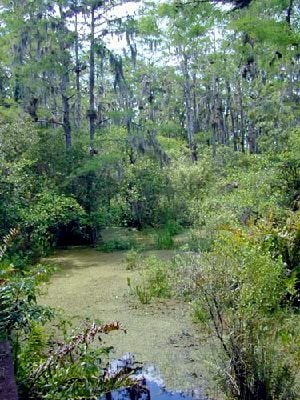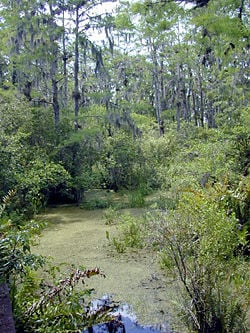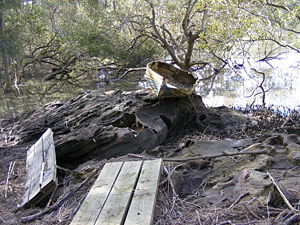Difference between revisions of "Swamp" - New World Encyclopedia
({{Contracted}}) |
Rick Swarts (talk | contribs) (added most recent Wikipedia version) |
||
| Line 1: | Line 1: | ||
{{Claimed}}{{Contracted}} | {{Claimed}}{{Contracted}} | ||
[[Image:Florida_freshwater_swamp_usgov_image.jpg|thumb|250px|right|A freshwater swamp]] | [[Image:Florida_freshwater_swamp_usgov_image.jpg|thumb|250px|right|A freshwater swamp]] | ||
| − | |||
| − | A '''swamp''' is a [[wetland]] that features permanent inundation of large areas of land by shallow bodies of water, generally with a substantial number of [[ | + | [[Image:Florida_freshwater_swamp_usgov_image.jpg|thumb|right|A freshwater swamp in [[Florida]].]] |
| + | [[Image:Swamp.jpg|thumb|right|300px|Swamp supporting wildlife.]] | ||
| + | A '''swamp''' is a [[wetland]] that features temporary or permanent inundation of large areas of land by shallow bodies of water, generally with a substantial number of [[hammock (ecology)|hammocks]], or dry-land protrusions, and covered by aquatic vegetation, or vegetation that tolerates periodical inundation.<ref>[http://www.nwrc.usgs.gov/fringe/glossary.html Swamp] (from glossary webpage of the [[United States Geological Survey]])</ref> The water of a swamp may be [[fresh water]] or [[salt water]]. A swamp is also generally defined as having no substantial [[peat]] deposits.<ref>[http://www.nsc.org/ehc/glossar2.htm Swamp] (from the glossary of the Environmental Health Center, [[National Safety Council]])</ref> | ||
| − | By contrast a [[marsh]] in | + | In North America, swamps are usually regarded as including a large amount of woody [[vegetation]], but elsewhere this may not necessarily apply, such as in African swamps dominated by [[papyrus]]. By contrast a [[marsh]] in North America is a wetland without woody vegetation, or elsewhere, a wetland without woody vegetation which is shallower and has less open water surface than a swamp. A '''mire''' (or '''quagmire''') is a low-lying wetland of deep, soft soil or mud that sinks underfoot. |
| − | Swamps are generally | + | ==Geology== |
| + | [[Image:2007 0817klklk0054.JPG|thumb|right|300px|A small swamp in the [[Hawkesbury River]], [[New South Wales]].]] | ||
| + | Swamps are generally characterised by very slow-moving waters. They are usually associated with adjacent [[river]]s or [[lake]]s. In some cases, rivers become swamps for a distance. Swamps are features of areas with very low [[topographic]] relief, although they may be surrounded by mountains. | ||
| − | + | ==Ecology== | |
| − | Swamps are | + | Swamps are characterised by rich biodiversity and specialised organisms such as frogs.<ref>[http://www.dnr.state.mn.us/reptiles_amphibians/frogs_toads/index.html Frogs & toads]</ref> For instance, southeastern U.S. swamps, such as those mentioned above, feature trees such as the [[Taxodium distichum|Bald cypress]] and [[Water tupelo]], which are adapted to growing in standing water, and [[animal]]s such as the [[American Alligator|American alligator]]. A common [[species]] name in biological [[Binomial nomenclature|nomenclature]] is the [[Latin]] ''palustris'', meaning "of the swamp". Examples of this are ''Quercus palustris'' ([[pin oak]]) and ''Thelypteris palustris'' (marsh [[fern]]). |
| − | + | ==Draining== | |
| − | [[Image:CypressSwamp.jpg|thumb | + | |
| + | Swamps were historically often [[drained]] to provide additional land for [[agriculture]], and to reduce the threat of diseases born by swamp insects and similar animals. Swamps were generally seen as useless and even dangerous. This practice of swamp draining is nowadays seen as a destruction of a very valuable ecological habitat type of which large tracts have already disappeared in many countries. | ||
| + | |||
| + | ==Famous examples== | ||
| + | |||
| + | ===In Iraq=== | ||
| + | |||
| + | The [[Tigris-Euphrates river system]] is a large swamp and river system in southern [[Iraq]], inhabited in part by the [[Marsh Arabs]]. It was partly drained by [[Saddam Hussein]] in the 1990s in retaliation against the [[Shiite]] tribes' revolt against his dictatorship. | ||
| + | |||
| + | [[Image:CypressSwamp.jpg|thumb|[[Taxodium distichum|Cypress]] swamp at [[Highlands Hammock State Park]], [[United States of America]].]] | ||
| + | ===In the United States=== | ||
| + | |||
| + | The most famous swamps in the [[United States]] are the [[Everglades]], [[Okefenokee Swamp]] and the [[Great Dismal Swamp]]. The Okefenokee is located in extreme southeastern [[Georgia (U.S. state)|Georgia]] and extends slightly into northeastern [[Florida]]. The Great Dismal Swamp lies in extreme southeastern [[Virginia]] and extreme northeastern [[North Carolina]]. Both are [[National Wildlife Refuge]]s. Another swamp area, [[Reelfoot Lake]] of extreme western [[Tennessee]], was created by the [[New Madrid fault zone|New Madrid earthquake]] of 1812. [[Caddo Lake]], the Great Dismal and Reelfoot are swamps that are centered at large lakes. Swamps are often called ''[[bayou]]s'' in the [[southeastern United States]], especially in the [[Gulf of Mexico|Gulf Coast]] region. | ||
==Heraldry== | ==Heraldry== | ||
| Line 41: | Line 56: | ||
* [[Honey Island Swamp]], Louisiana, United States | * [[Honey Island Swamp]], Louisiana, United States | ||
* [[Great Swamp National Wildlife Refuge]], New Jersey, United States | * [[Great Swamp National Wildlife Refuge]], New Jersey, United States | ||
| − | * [[Atchafalaya National Wildlife Refuge]], Louisiana, United States | + | * [[Atchafalaya National Wildlife Refuge]], Louisiana, United States |
| + | |||
===South America=== | ===South America=== | ||
* [[Lahuen Ñadi]], [[Chile]] | * [[Lahuen Ñadi]], [[Chile]] | ||
| Line 48: | Line 64: | ||
==See also== | ==See also== | ||
| − | + | {| | |
| − | *[[ | + | |-valign=top |
| − | *[[ | + | | |
| + | *[[Aquatic plant]] | ||
| + | *[[Bog]] | ||
*[[Hydrogen sulfide]] | *[[Hydrogen sulfide]] | ||
*[[Marsh]] | *[[Marsh]] | ||
| + | | width=40 | | ||
| + | | | ||
| + | *[[Marsh gas]] | ||
*[[Muck (soil)|Muck]] | *[[Muck (soil)|Muck]] | ||
*[[Peat]] | *[[Peat]] | ||
| − | *[[ | + | *[[Salt marsh]] |
| − | *[[ | + | | width=40 | |
| + | | | ||
| + | *[[Slough (wetland)|Slough]] | ||
| + | *[[Wetland]] | ||
| + | *[[Will o' the wisp]] | ||
| + | |} | ||
| + | |||
| + | ==References== | ||
| + | <references/> | ||
| + | <br> | ||
[[Category:Life sciences]] | [[Category:Life sciences]] | ||
| − | {{credit| | + | {{credit|Swamp&oldid=171316706}} |
Revision as of 17:59, 15 November 2007

A swamp is a wetland that features temporary or permanent inundation of large areas of land by shallow bodies of water, generally with a substantial number of hammocks, or dry-land protrusions, and covered by aquatic vegetation, or vegetation that tolerates periodical inundation.[1] The water of a swamp may be fresh water or salt water. A swamp is also generally defined as having no substantial peat deposits.[2]
In North America, swamps are usually regarded as including a large amount of woody vegetation, but elsewhere this may not necessarily apply, such as in African swamps dominated by papyrus. By contrast a marsh in North America is a wetland without woody vegetation, or elsewhere, a wetland without woody vegetation which is shallower and has less open water surface than a swamp. A mire (or quagmire) is a low-lying wetland of deep, soft soil or mud that sinks underfoot.
Geology
Swamps are generally characterised by very slow-moving waters. They are usually associated with adjacent rivers or lakes. In some cases, rivers become swamps for a distance. Swamps are features of areas with very low topographic relief, although they may be surrounded by mountains.
Ecology
Swamps are characterised by rich biodiversity and specialised organisms such as frogs.[3] For instance, southeastern U.S. swamps, such as those mentioned above, feature trees such as the Bald cypress and Water tupelo, which are adapted to growing in standing water, and animals such as the American alligator. A common species name in biological nomenclature is the Latin palustris, meaning "of the swamp". Examples of this are Quercus palustris (pin oak) and Thelypteris palustris (marsh fern).
Draining
Swamps were historically often drained to provide additional land for agriculture, and to reduce the threat of diseases born by swamp insects and similar animals. Swamps were generally seen as useless and even dangerous. This practice of swamp draining is nowadays seen as a destruction of a very valuable ecological habitat type of which large tracts have already disappeared in many countries.
Famous examples
In Iraq
The Tigris-Euphrates river system is a large swamp and river system in southern Iraq, inhabited in part by the Marsh Arabs. It was partly drained by Saddam Hussein in the 1990s in retaliation against the Shiite tribes' revolt against his dictatorship.

In the United States
The most famous swamps in the United States are the Everglades, Okefenokee Swamp and the Great Dismal Swamp. The Okefenokee is located in extreme southeastern Georgia and extends slightly into northeastern Florida. The Great Dismal Swamp lies in extreme southeastern Virginia and extreme northeastern North Carolina. Both are National Wildlife Refuges. Another swamp area, Reelfoot Lake of extreme western Tennessee, was created by the New Madrid earthquake of 1812. Caddo Lake, the Great Dismal and Reelfoot are swamps that are centered at large lakes. Swamps are often called bayous in the southeastern United States, especially in the Gulf Coast region.
Heraldry
A swamp appears in the coat of arms of Gesturi, Italy.
List of major swamps
Africa
Asia
North America
- Great Black Swamp, United States
- Great Dismal Swamp, United States
- Great Pocomoke Swamp also known as Great Cypress Swamp, Maryland, United States
- Okefenokee Swamp, Georgia/Florida, United States
- Reelfoot Lake, United States
- Big Cypress National Preserve, Florida, United States
- Limberlost, Indiana, United States
- Honey Island Swamp, Louisiana, United States
- Great Swamp National Wildlife Refuge, New Jersey, United States
- Atchafalaya National Wildlife Refuge, Louisiana, United States
South America
See also
|
|
|
ReferencesISBN links support NWE through referral fees
Credits
New World Encyclopedia writers and editors rewrote and completed the Wikipedia article in accordance with New World Encyclopedia standards. This article abides by terms of the Creative Commons CC-by-sa 3.0 License (CC-by-sa), which may be used and disseminated with proper attribution. Credit is due under the terms of this license that can reference both the New World Encyclopedia contributors and the selfless volunteer contributors of the Wikimedia Foundation. To cite this article click here for a list of acceptable citing formats.The history of earlier contributions by wikipedians is accessible to researchers here:
The history of this article since it was imported to New World Encyclopedia:
Note: Some restrictions may apply to use of individual images which are separately licensed.


